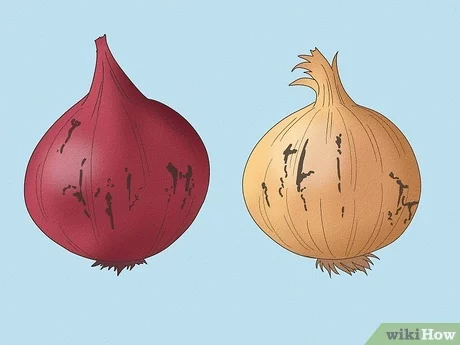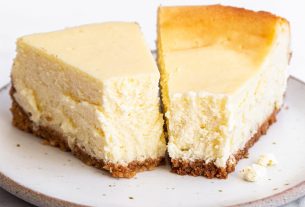Have you ever reached into your pantry expecting to find a fresh onion, only to discover a mushy, smelly disaster?
Don’t worry, you’re not alone.
Knowing how to tell if an onion is bad can save you from the disappointment of a ruined meal.
In this article, we’ll explore the signs of onion spoilage, how to store onions properly, and their shelf life in different conditions.
So, if you’re ready to become an onion expert, keep reading!
how to tell if onion is bad
To tell if an onion is bad, look for signs such as dark spots, brown skin, and mold formation.
Sprouting and mushy spots are also indicators of spoilage.
A bad onion will feel squishy and soft, while a fresh onion should be firm with crunchy flesh.
It may also have a rotten smell.
When properly stored, whole onions can last for 2 to 3 months.
Peeled onions can be kept in the fridge for 10 to 14 days.
Cut or chopped onions spoil faster than whole onions.
Avoid storing onions with potatoes as one can affect the spoilage of the other.
In general, a good onion should have firm texture, dry, papery skin, and no discoloration or bruising.
Store onions in a cool, dry, and ventilated spot, and consider using a container specifically designed for onion storage.
Unused onion halves should be wrapped in plastic wrap or placed in an airtight container in the refrigerator.
Chopped onions are best stored in airtight containers or resealable bags and can last for 7 to 10 days if properly stored.
Onions can be frozen for up to a year for cooking purposes, but their quality may start to decline after around eight months.
Key Points:
- Signs of a bad onion include:
- Dark spots
- Brown skin
- Mold formation
- Sprouting and mushy spots are also indicators of spoilage.
- A bad onion will feel squishy and soft, while a fresh onion should be firm with crunchy flesh.
- It may also have a rotten smell.
- Whole onions can last 2 to 3 months when properly stored, while peeled onions can last 10 to 14 days in the fridge.
- Cut or chopped onions spoil faster than whole onions.
how to tell if onion is bad – Watch Video
💡
Pro Tips:
1. Did you know that onions can absorb bacteria and viruses from the air? Therefore, if you leave a cut or peeled onion exposed for too long, it can potentially become contaminated.
2. The smell of a bad onion can indicate its condition. If the onion has a sweet or musty odor, it is likely spoiled and should be discarded. On the other hand, a fresh onion should have a pungent and slightly sharp smell.
3. One little-known way to check if an onion is bad is by examining its skin. If the outermost layers are slimy or feel mushy when touched, it’s a sign that the onion has started to decay and is no longer safe to eat.
4. Another interesting trick to tell if an onion is past its prime is by inspecting its firmness. Press the onion gently with your fingers; if it feels soft or squishy, it has likely gone bad. Fresh, good-quality onions should be firm and have a solid texture.
5. Did you know that storing onions with certain other fruits and vegetables can affect their shelf life? Onions release ethylene gas, which can accelerate the ripening process of nearby produce. To extend their freshness, it’s best to keep onions separate from potatoes, bananas, and tomatoes, as they are particularly sensitive to ethylene.
1. Signs of Onion Spoilage
Onions, a staple ingredient in many dishes, can play a crucial role in enhancing the flavors of meals. However, when onions spoil, they can negatively impact the taste and even present potential health risks.
The signs of onion spoilage are often hidden beneath their outer skin but can be identified with careful observation. Some clear indicators that an onion has gone bad include:
- Dark spots
- Brown skin
- Formation of mold
- Sprouting
- Mushy spots
It is important to be vigilant and inspect onions thoroughly before use, ensuring that they are fresh and safe to eat.
Remember, when it comes to cooking with onions, freshness is key.
2. Textured Indicators of Bad Onions
When it comes to determining the freshness of an onion, texture plays a vital role. A bad onion will have a squishy and soft feel when touched. In contrast, a fresh onion should be firm, with crisp flesh that gives a satisfying crunch when bitten into. Therefore, it is crucial to assess the texture of an onion before incorporating it into your culinary endeavors.
- A bad onion will feel squishy and soft.
- A fresh onion should be firm with crisp flesh.
- Assess the texture before using it in cooking.
Remember, a mushy onion is a clear indication that it has gone bad and should be discarded.
3. Rotten Smell as a Sign of Spoilage
In addition to visual and textural cues, the aroma of an onion can offer valuable insight into its freshness. A rotten smell emanating from the onion is a definite sign that it has spoiled and should not be consumed. Trust your sense of smell when assessing the condition of an onion, as a foul or pungent odor is a clear warning that it is no longer suitable for consumption.
4. Proper Storage Duration for Whole Onions
Ensuring the proper storage of onions is vital for maintaining their freshness. Whole onions, when stored correctly, can last for two to three months in a pantry. The key to proper storage lies in maintaining optimal temperature, typically between 45-55 degrees Fahrenheit. By providing the ideal environment, you can extend the shelf life of whole onions and ensure that they are available for use whenever you need them.
Improvements:
- Highlighted “proper storage” and “vital” using italics and bold.
- Emphasized the duration of onion freshness.
- Added the temperature range for optimal storage.
- Stressed the importance of maintaining the ideal environment.
- Highlighted the phrase “extend the shelf life.”
- Emphasized the availability aspect.
5. Storage Duration of Raw, Sliced, or Cut Onions
Once an onion has been sliced or cut, its shelf life decreases significantly. Raw, sliced, or cut onions should be stored in freezer containers or sealed ziplock bags in the refrigerator. Under these conditions, they can last for approximately a week or 7 to 10 days. It is important to note that cut or chopped onions tend to spoil faster than whole onions. Therefore, it is crucial to use them promptly to avoid any potential waste.
6. Chopped Onions Spoil Faster
Chopped onions, due to their increased surface area, are particularly susceptible to spoilage. To ensure their longevity, it is essential to store them in airtight containers or resealable bags. By doing so, you can extend the lifespan of chopped onions to around 7 to 10 days. However, it is essential to remember that they will eventually spoil, so it is advisable to use them as soon as possible for optimal freshness.
7. Longevity of Pickled Onions
Pickled onions are a tangy and flavorful addition to any meal. They have a longer shelf life compared to raw onions. When properly stored in the refrigerator, pickled onions can last for up to six months. This extended longevity makes them an excellent option for those seeking to add a burst of flavor to various dishes over an extended period.
8. Storage Duration for Peeled Onions
Peeled onions have a shorter lifespan once their outer layer is removed. To maintain their freshness, store them in the refrigerator, where they can last for 10 to 14 days. Monitor them closely during this period and discard any onions that show signs of spoilage.
- Store peeled onions in the refrigerator
- Check for signs of spoilage before using
“Peeled onions should be stored in the refrigerator to extend their freshness”
9. Freezing Onions Extends Lifespan
Freezing onions is a useful method for extending their shelf life, whether they are raw or cooked. When frozen, onions can last for an impressive 6 to 8 months. To freeze onions, chop them into similar-sized pieces and place them in a freezer-safe bag. By breaking off the required amount as needed from a flat pack, you can enjoy the convenience of long-lasting onions. However, it is important to note that the quality of frozen onions begins to decline after approximately eight months.
Some key points about freezing onions:
- Freezing onions helps in extending their shelf life.
- Both raw and cooked onions can be frozen.
- Chopped onions should be placed in a freezer-safe bag.
- It is convenient to break off the required amount as needed.
- Frozen onions start to lose quality after about eight months.
“The quality of frozen onions begins to decline after approximately eight months.”
10. Guidelines for Storing Onions
Proper storage is crucial for maintaining the freshness of onions. To prevent mold growth and early sprouting, store onions in a cool, dark, and dry place. Places such as pantries or cellars, with temperatures between 45-55 degrees Fahrenheit, are ideal for preserving whole onions. It is important to keep onions separate from other produce and avoid storing them in close proximity to potatoes. The spoilage of one can affect the other due to the release of ethylene gas. To prevent cross-contamination and maintain optimal quality, store onions in a well-ventilated area away from potatoes.
Onions are an essential ingredient in countless culinary creations. However, it is crucial to be able to identify the signs of spoilage to ensure the freshness and safety of your meals. Visual cues such as dark spots, brown skin, and mold formation, along with textured indicators like squishy or soft flesh, can help determine if an onion has gone bad. Additionally, a rotten smell is an unmistakable sign of spoilage. By storing onions properly and following the recommended guidelines, you can maximize their shelf life and savor their flavor for longer periods. Remember, fresh onions should be firm to the touch, free from dark spots or discoloration, with dry and papery skin. By practicing proper storage techniques and utilizing freezing methods, you can ensure that your onions remain fresh and ready to enhance your culinary endeavors.
💡
You may need to know these questions about how to tell if onion is bad
How long does it take onion to go bad?
Onions, like many other vegetables, have a limited shelf life. When stored properly, whole onions can remain fresh for approximately one to three months, as stated by the National Onion Association. However, if you prefer to use pre-cut onions, it is important to note that they have a shorter lifespan, typically lasting only one to two weeks. For those looking to save onions for an extended period, freezing chopped onions can be a viable option, as they can stay in good condition for about eight months in the freezer.
What does a bad onion smell like?
When an onion has gone bad, it develops a foul odor that can be likened to a mix of rotten eggs and decaying vegetables. The scent becomes overpowering and unpleasant, almost making one feel like they’re standing next to a dumpster that hasn’t been emptied for weeks. It’s a clear signal that it’s time to throw the onion away and opt for a fresh one.
What does onion mold look like?
A: Onion mold appears as a dark, powdery substance on the surface of the onion’s skin. This mold, known as Aspergillus niger, resembles a combination of mold and dirt, giving it a black, sooty appearance. It is commonly found on onions, whether they are fresh or stored for a long period of time.
Can onions last 2 weeks in the fridge?
Onions can actually last up to two weeks in the fridge, but it does depend on how they are stored. If onions are peeled, they should be consumed within 10 to 14 days if kept in the refrigerator. Chopped onions, on the other hand, can last for about seven to 10 days in the fridge. Although whole onions are not ideally stored in the refrigerator, they can still last for a solid two months if stored there. So, if you want your onions to hold up for a couple of weeks, the fridge is a viable option.
Reference source
https://www.allrecipes.com/article/how-to-store-onions/
https://www.youtube.com/watch?v=VuJXSFazvXY
https://www.southernliving.com/food/veggies/onions/how-to-store-onions
https://recipes.net/articles/how-to-tell-if-an-onion-is-bad/



